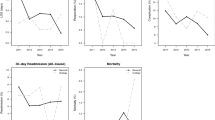Abstract
Background
Surgeon experience has been demonstrated to result in better outcomes after a variety of advanced operations. Less information is available regarding adrenal surgery. We compared the outcomes after adrenalectomy for a variety of indications and determined the effect of surgeon’s case volume.
Methods
Cross-sectional analysis was performed using ICD-9 procedure codes included in the Nationwide Inpatient Sample from 2003 to 2009 to identify all adult patients who underwent unilateral or bilateral adrenalectomy for benign or malignant conditions. Logistic regression was used to test for interaction between surgeon case volume (low = 1, intermediate = 2–5, and high = >5 adrenalectomies per year), diagnosis, type of operation performed, and risk of complications.
Results
A total of 7,829 adrenalectomies were included. Risk of complications after bilateral adrenalectomy was 23.4 % compared to 15.0 % for unilateral adrenalectomy (odds ratio 2.165, 95 % confidence interval 1.335, 3.512). Malignancy was associated with higher risk of complication (23.1 %) than benign disease (13.2 %) (odds ratio 1.685, 95 % confidence interval 1.371, 2.072). Complication rates for low- and intermediate-volume surgeons were 18.8 and 14.6 %, respectively, and both were significantly higher than complications by high-volume surgeons (11.6 %, p < 0.05). Length of stay and charges were both significantly less for high-volume surgeons compared to lower-volume groups (p < 0.05).
Conclusions
Low surgeon case volumes and adrenal surgery for malignant or bilateral disease are associated with increased risk of postoperative complications. Length of stay and charges were significantly less when high-volume surgeons perform adrenal surgery.

Similar content being viewed by others
References
Saunders BD, Wainess RM, Dimick JB, Upchurch GR, Doherty GM, Gauger PG. Trends in utilization of adrenalectomy in the United States: have indications changed? World J Surg. 2004;28:1169–75.
Abecassis M, McLoughlin MJ, Langer B, Kudlow JE. Serendipitous adrenal masses: prevalence, significance, and management. Am J Surg. 1985;149:783–8.
Bovio S, Cataldi A, Reimondo G, et al. Prevalence of adrenal incidentaloma in a contemporary computerized tomography series. J Endocrinol Invest. 2006;29:298–302.
Song JH, Chaudhry FS, Mayo-Smith WW. The incidental adrenal mass on CT: prevalence of adrenal disease in 1,049 consecutive adrenal masses in patients with no known malignancy. AJR Am J Roentgenol. 2008;190:1163–8.
Saunders BD, Wainess RM, Dimick JB, Doherty GM, Upchurch GR, Gauger PG. Who performs endocrine operations in the United States? Surgery. 2003;134:924–31.
Chen H, Zeiger MA, Gordon TA, Udelsman R. Parathyroidectomy in Maryland: effects of an endocrine center. Surgery. 1996;120:948–53.
Zelen J, Bilfinger TV, Anagnostopoulos CE. Coronary artery bypass grafting: the relationship of surgical volume, hospital location, and outcome. NY State J Med. 1991;91:290–2.
Birkmeyer JD, Stukel TA, Siewers AE, Goodney PP, Wennberg DE, Lucas FL. Surgeon volume and operative mortality in the United States. N Engl J Med. 2003;349:2117–27.
Dimick JB, Cowan JA Jr, Stanley JC, Henke PK, Pronovost PJ, Upchurch GR Jr. Surgeon specialty and provider volumes are related to outcome of intact abdominal aortic aneurysm repair in the United States. J Vasc Surg. 2003;38:739–44.
Courcoulas A, Schuchert M, Gatti G, Luketich J. The relationship of surgeon and hospital volume to outcome after gastric bypass surgery in Pennsylvania: a 3 years summary. Surgery. 2003;134:613–23.
Nguyen NT, Paya M, Stevens CM, Mavandadi S, Zainabadi K, Wilson SE. The relationship between hospital volume and outcome in bariatric surgery at academic medical centers. Ann Surg. 2004;240:586–94.
Ho V, Heslin MJ. Effect of hospital volume and experience on in-hospital mortality for pancreaticoduodenectomy. Ann Surg. 2003;237:509–14.
Sosa JA, Bowman HM, Gordon TA, et al. Importance of hospital volume in the overall management of pancreatic cancer. Ann Surg. 1998;228:429–38.
Casson AG, Van Lanschot JJ. Improving outcomes after esophagectomy: the impact of operative volume. J Surg Oncol. 2005;92:262–6.
Wang T. Endocrine surgery. Am J Surg. 2011;202:369–71.
Park HS, Roman SA, Sosa JA. Outcomes from 3144 adrenalectomies in the United States: which matters more, surgeon volume or specialty? Arch Surg. 2009;144:1060–7.
HCUP Databases. Healthcare Cost and Utilization Project. Agency for Healthcare Research and Quality, Rockville. 2014. http://www.hcup-us.ahrq.gov/nisoverview.jsp. Accessed 7 Feb 2014.
Stavrakis AI, Ituarte PH, Ko CY, Yeh MW. Surgeon volume as a predictor of outcomes in inpatient and outpatient endocrine surgery. Surgery. 2007;142:887–99.
Quan H, Sundararajan V, Halfon P, et al. Coding algorithms for defining comorbidities in ICD-9CM and ICD-10 administrative data. Med Care. 2005;43:1130–9.
Gallagher SF, Wahi M, Haines KL, et al. Trends in adrenalectomy rates, indications, and physician volume: A statewide analysis of 1816 adrenalectomies. Surgery. 2007;142:1011–21.
Harness JK, Organ CH Jr, Thompson NW. Operative experience of US general surgery residents with diseases of the adrenal glands, endocrine pancreas, and other less common endocrine organs. World J Surg. 1996;20:885–90.
Le D, Karmali S, Harness JK, Sheppard BC. An update: the operative experience in adrenal, pancreatic, and other less common endocrine diseases of US general surgery residents. World J Surg. 2008;32:232–6.
Quan H, Li B, Saunders LD, et al. Assessing validity of ICD-9-CM and ICD-10 administrative data in recording clinical conditions in a unique dually coded database. Health Serv Res. 2008;43:1424–41.
Disclosure
The authors have nothing to disclose.
Author information
Authors and Affiliations
Corresponding author
Rights and permissions
About this article
Cite this article
Hauch, A., Al-Qurayshi, Z. & Kandil, E. Factors Associated with Higher Risk of Complications After Adrenal Surgery. Ann Surg Oncol 22, 103–110 (2015). https://doi.org/10.1245/s10434-014-3750-2
Received:
Published:
Issue Date:
DOI: https://doi.org/10.1245/s10434-014-3750-2



